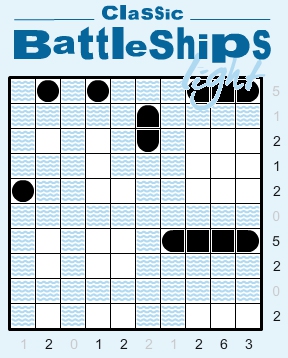Classic Battleships Light

![]() If you've been hanging around this part of town long enough, you've noticed some familiar-looking characters rolling into town. First, you saw a bunch of sudoku puzzles strolling down the street, then a party of picross close behind. Now pulling into the harbor is an entire fleet of battleships. We're gonna need a bigger harbor! Classic Battleships Light is the next addition to the Conceptis series of logic puzzle packs.
If you've been hanging around this part of town long enough, you've noticed some familiar-looking characters rolling into town. First, you saw a bunch of sudoku puzzles strolling down the street, then a party of picross close behind. Now pulling into the harbor is an entire fleet of battleships. We're gonna need a bigger harbor! Classic Battleships Light is the next addition to the Conceptis series of logic puzzle packs.
The goal of each nautical conundrum is to place the fleet of six (ten in larger puzzles) ships into the grid so that each row and column contains the number of ship segments indicated along the edges. Ships may be placed horizontally and vertically within the grid, but there must be a one-space border around every ship. Some puzzles might give you a couple of starting segments to help you set sail in the right direction, but after that, you're on your own.
To fill a spot on the grid with water, click on a blank square. To fill it with a ship segment, click again. A third click reverts the square back to the blank state. You can fill in multiple squares at once by clicking one square to the desired contents and dragging through the boxes you want to fill. For the puzzle to register that you've finished, you have to fill in every square in the grid with either water or ship.
This puzzle pack contains thirty puzzles (ten each of 6x6, 8x8, and 10x10 sizes). Unfortunately, if you're already familiar with this type of puzzle, you may not find the lot to be very challenging. If you're used to the puzzles posted on the Conceptis website, you'd find that almost all of these puzzles would rank in what they'd call the "Easy" or "Very Easy" categories, barely touching into "Medium" territory. Nonetheless, this set is a great little introduction to the Battleships logic puzzle for those who have never tried it before. And considering that this is only the first volume of a periodically-released series, we can count on seeing more (and harder) puzzles in the future.
So then, will you sink or swim? With this new batch of quality puzzles, any experience level can dive right in. Anchors aweigh! (And there's plenty more ship puns where that came from.)






Walkthrough Guide
(Please allow page to fully load for spoiler tags to be functional.)
Battleships Classic Tips and Tricks
Getting Started
A good way to begin is each puzzle is to look for 0s along the edges. Any row or column marked with a 0 can instantly be filled with water.
Next, look for rows and columns that have exactly enough spaces left to be completely filled with ship pieces. Keeping an eye out for higher numbers can help you spot areas with lots of ships to fill in.
After you've started filling in some ships, watch for rows and columns with low numbers that might already have their requisite number of ship pieces and fill what's left in with water. If you alternate between this step and the previous step, you can clear a large portion of these puzzles quickly.
Advanced Techniques
Remember that the shapes of the ships are important. One-piece ships are always circles, and three- and four-piece ships always have squares in the middle. If one of these shapes is present at the start of the puzzle, you can narrow down what size of ship you'll be dealing with.
Keep your largest ships in mind. As you place more water, you'll notice that there are fewer places that three- and four-piece ships can fit. If you use the numbers along the sides, you can easily narrow down where they might go.
If you have a puzzle that starts off with a square ship piece as a provided hint, you know it must be in the middle of a ship, although you can't immediately determine whether the ship will run horizontally or vertically. However, if you use the numbers along the sides as a clue, you could eliminate one of the directions if placing the ship in a certain direction means that the row or column would be overfilled.
I think I've finished, but it hasn't said I've won yet. What did I do wrong?
Check to make sure you didn't go over the quotas for ships. It's easy to accidentally put in too many one- or two-piece ships to finish a grid.
Make sure no ships are diagonally touching. Remember that there must be a one-space border around every ship, regardless of their size.
Posted by: Steve |
January 11, 2011 10:01 AM
|
January 11, 2011 10:01 AM